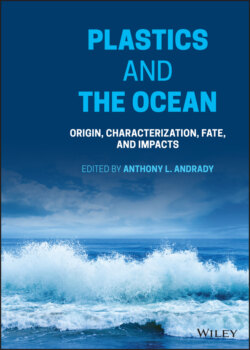Читать книгу Plastics and the Ocean - Группа авторов - Страница 19
1.2.3 Chemicals in Plastic Debris
ОглавлениеPlastics used in products typically include a suite of chemicals intimately mixed with the base resin. These include (i) intentionally added chemicals or additives to modify the properties of the base resin to suit the needs of the product (Groh et al. 2019; see Chapter 2); (ii) low levels of the relevant residual monomer trapped in the plastic (not an issue with PE or PP with gaseous monomers, but relevant with PS, PVC or polycarbonate [PC]); and (iii) unintended compounds sorbed from seawater and concentrated by partition (Hüffer and Hofmann, 2016; Pascall et al. 2005; Rochman et al. 2013; see Chapter 9). Some of these sorbed chemicals are persistent organic pollutants (POPs) that are toxic compounds as well, and remain in the environment for extended durations, allowing them to be widely distributed via water, soil, and air. These tend to accumulate in the fatty tissue of animals that ingest them and may bio‐magnify as they move to higher trophic levels. Any POPs in seafood are of special interest to human consumers. Despite their very low dissolved concentration in seawater, the equilibrium concentration of POPs in the MPs and NPs tends to be very high, reaching concentrations that are ~2 to 6 orders of magnitude higher than in sediment (Mato et al. 2001) or seawater (Wright et al. 2013). Sorption cleans the water of these pollutants but in the process, also generates MPs loaded with POPs, heavy metal compounds, and pharmaceuticals, ingestible by marine biota.
